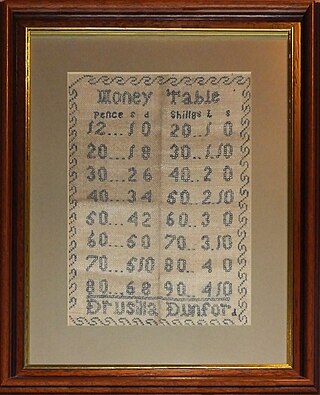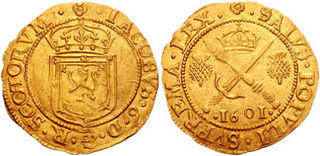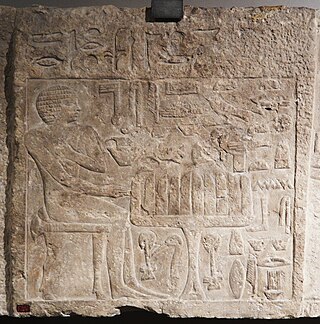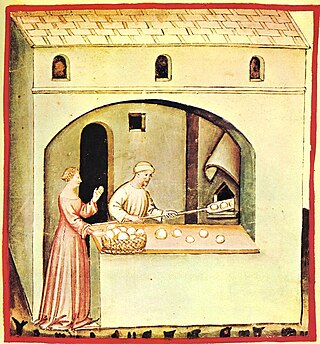
The standard circulating coinage of the United Kingdom, British Crown Dependencies and British Overseas Territories is denominated in pennies and pounds sterling, and ranges in value from one penny sterling to two pounds. Since decimalisation, on 15 February 1971, the pound has been divided into 100 (new) pence. Before decimalisation, twelve pence made a shilling, and twenty shillings made a pound.

A penny is a coin or a unit of currency in various countries. Borrowed from the Carolingian denarius, it is usually the smallest denomination within a currency system. Presently, it is the formal name of the British penny (abbr. p) and the de facto name of the American one-cent coin (abbr. ¢) as well as the informal Irish designation of the 1 cent euro coin (abbr. c). Due to inflation, pennies have lost virtually all their purchasing power and are often viewed as an expensive burden to merchants, banks, government mints and the public in general.

Sterling is the currency of the United Kingdom and nine of its associated territories. The pound is the main unit of sterling, and the word "pound" is also used to refer to the British currency generally, often qualified in international contexts as the British pound or the pound sterling.

A bushel is an imperial and US customary unit of volume based upon an earlier measure of dry capacity. The old bushel is equal to 2 kennings (obsolete), 4 pecks, or 8 dry gallons, and was used mostly for agricultural products, such as wheat. In modern usage, the volume is nominal, with bushels denoting a mass defined differently for each commodity.

£sd, spoken as "pounds, shillings and pence", is the popular name for the pre-decimal currencies once common throughout Europe. The abbreviation originates from the Latin currency denominations librae, solidi, and denarii. In the United Kingdom, these were referred to as pounds, shillings, and pence.
Assize or Assizes, in Old French originally "meeting, conference", may refer to judicial institutions or legal measures taken by those.

The pound was the currency of Scotland prior to the 1707 Treaty of Union between the Kingdom of Scotland and the Kingdom of England, which created the Kingdom of Great Britain. It was introduced by David I, in the 12th century, on the Carolingian monetary system of a pound divided into 20 shillings, each of 12 pence. The Scottish currency was later devalued relative to sterling by debasement of its coinage. By the time of James III, one pound Scots was valued at five shillings sterling.
English units were the units of measurement used in England up to 1826, which evolved as a combination of the Anglo-Saxon and Roman systems of units. Various standards have applied to English units at different times, in different places, and for different applications.

Beer is one of the oldest human-produced drinks. The first chemically confirmed barley-beer – from the area of Mesopotamia, part of modern-day Iraq – dates back to the 5th millennium BCE. The written history of ancient Egypt and Mesopotamia records the use of beer, and the drink has spread throughout the world; a 3,900-year-old Sumerian poem honouring Ninkasi, the patron goddess of brewing, contains the oldest surviving beer-recipe, describing the production of beer from barley bread, and in China, residue on pottery dating from around 5,000 years ago shows that beer was brewed using barley and other grains.
An ale-conner was an officer appointed yearly at the court-leet of ancient English communities to ensure the quality of bread, ale, and beer, as well as regulating the measures in which they were sold and their prices. There were many different names for this position which varied from place to place: "ale-tasters", gustatores cervisiae, "ale-founders", and "ale-conners". Ale-conners were also often trusted to ensure that the beer was sold at a fair price.
A corrody was a lifetime allowance of food and clothing, and often shelter and care, granted by an abbey, monastery, or other religious house. While rarely granted in the modern era, corrodies were common in the Middle Ages. They were routinely awarded to the servants and household staff of royalty, and as a form of charity for the aged, sick, feeble or those in poverty, but could also be purchased with donations of money or land. The corrody is one of the earliest forms of insurance, as it provided security in sustenance and lodging in a time when social welfare was scarce.

Weights and measures acts are acts of the British Parliament determining the regulation of weights and measures. It also refers to similar royal and parliamentary acts of the Kingdoms of England and Scotland and the medieval Welsh states. The earliest of these were originally untitled but were given descriptive glosses or titles based upon the monarch under whose reign they were promulgated. Several omnibus modern acts are entitled the Weights and Measures Act and are distinguished by the year of their enactment.
Winchester measure is a set of legal standards of volume instituted in the late 15th century (1495) by King Henry VII of England and in use, with some modifications, until the present day. It consists of the Winchester bushel and its dependent quantities, the peck, (dry) gallon and (dry) quart. They would later become known as the Winchester Standards, named because the examples were kept in the city of Winchester.

Bread was central to the formation of early human societies. From the Fertile Crescent, where wheat was domesticated, cultivation spread north and west, to Europe and North Africa, and east towards East Asia. This in turn led to the formation of towns, as opposed to the nomadic lifestyle and gave rise to more and more sophisticated forms of societal organization. Similar developments occurred in the Americas with maize and in Asia with rice.
A penny bun or a penny loaf was a small bread bun or loaf which cost one old penny at the time when there were 240 pence to the pound. A penny loaf was a common size loaf of bread in England regulated by the Assize of Bread and Ale act of 1266. The size of the loaf could vary depending on the prevailing cost of the flour used in the baking. The nursery rhyme London Bridge Is Falling Down has a version which includes the line "Build it up with penny loaves".

Beer in Scotland is mostly produced by breweries in the central Lowlands, which also contain the main centres of population. Edinburgh and Alloa in particular became noted for the export of beer around the world in the 19th century.
The ceiniog was the basic currency of the medieval Welsh kingdoms such as Gwynedd and Deheubarth. Hywel Dda was the only ruler recorded as minting his own proper coins; however, the ceiniog was not a coin but a value of silver. The "legal penny" was the weight of 32 wheat grains in silver; the "curt penny", the weight of 24 wheat grains. The latter was based on the old Roman pound; the former, Charlemagne's and Offa's. The Welsh half-penny was the dymey of 12 wheat grains and the farthing (quarter-penny) was the firdlyc of 6.
The quarter was used as the name of several distinct English units based on ¼ sizes of some base unit.
The Exchequer Standards may refer to the set of official English standards for weights and measures created by Queen Elizabeth I, and in effect from 1588 to 1825, when the Imperial units system took effect, or to the whole range of English unit standards maintained by the Court of the Exchequer from the 1200s, or to the physical reference standards physically kept at the Exchequer and used as the legal reference until the such responsibility was transferred in the 1860s, after the Imperial system had been established.

A vantage loaf or vantage of bread is the thirteenth loaf of a baker's dozen, a loaf of bread which is to the buyer's advantage, being in addition to the number ordered.